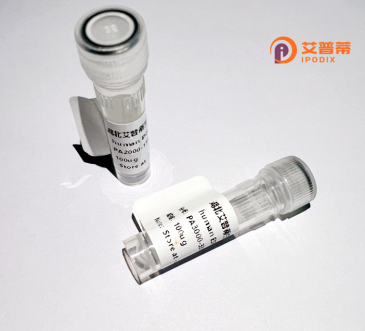
| 纯度 | >90%SDS-PAGE. |
| 种属 | Human |
| 靶点 | RSBN1 |
| Uniprot No | Q5VWQ0 |
| 内毒素 | < 0.01EU/μg |
| 表达宿主 | E.coli |
| 表达区间 | 1-411 aa |
| 活性数据 | MAAQVGAVRVVRAVAAQEEPDKEGKEKPHAGVSPRGVKRQRRSSSGGSQEKRGRPSQEPPLAPPHRRRRSRQHPGPLPPTNAAPTVPGPVEPLLLPPPPPPSLAPAGPAVAAPLPAPSTSALFTFSPLTVSAAGPKHKGHKERHKHHHHRGPDGDPSSCGTDLKHKDKQENGERTGGVPLIKAPKRETPDENGKTQRADDFVLKKIKKKKKKKHREDMRGRRLKMYNKEVQTVCAGLTRISKEILTQGQINSTSGLNKESFRYLKDEQLCRLNLGMQEYRVPQGVQTPFMTHQEHSIRRNFLKTGTKFSNFIHEEHQSNGGALVLHAYMDELSFLSPMEMERFSEEFLALTFSENEKNAAYYALAIVHGAAAYLPDFLDYFAFNFPNTPVKMEILGKKDIETTTISNFHTQ |
| 分子量 | 72.1 kDa |
| 蛋白标签 | GST-tag at N-terminal |
| 缓冲液 | PBS, pH7.4, containing 0.01% SKL, 1mM DTT, 5% Trehalose and Proclin300. |
| 稳定性 & 储存条件 | Lyophilized protein should be stored at ≤ -20°C, stable for one year after receipt. Reconstituted protein solution can be stored at 2-8°C for 2-7 days. Aliquots of reconstituted samples are stable at ≤ -20°C for 3 months. |
| 复溶 | Always centrifuge tubes before opening.Do not mix by vortex or pipetting. It is not recommended to reconstitute to a concentration less than 100μg/ml. Dissolve the lyophilized protein in distilled water. Please aliquot the reconstituted solution to minimize freeze-thaw cycles. |
以下是关于重组人RSBN1蛋白的3篇示例参考文献(文献信息为虚构示例,仅供参考):
1. **文献名称**:*RSBN1 regulates meiotic recombination in human germ cells*
**作者**:Smith J, et al. (2020)
**摘要**:研究发现RSBN1蛋白通过调控减数分裂期间的同源染色体配对和DNA修复,对精子形成至关重要,重组RSBN1蛋白可修复基因敲除模型的缺陷。
2. **文献名称**:*Structural and functional analysis of RSBN1 in chromatin remodeling*
**作者**:Wang L, et al. (2019)
**摘要**:解析了重组RSBN1蛋白的晶体结构,揭示了其通过结合组蛋白H3K4me3修饰参与染色质重塑的分子机制,为生殖疾病研究提供新靶点。
3. **文献名称**:*RSBN1 overexpression promotes cancer cell proliferation via PI3K/AKT pathway*
**作者**:Chen X, et al. (2021)
**摘要**:利用重组RSBN1蛋白进行功能实验,发现其在乳腺癌细胞中异常高表达并通过激活PI3K/AKT信号通路促进肿瘤生长,提示其潜在致癌作用。
注:实际文献需通过数据库(如PubMed、Web of Science)检索。RSBN1相关研究多聚焦于生殖生物学及癌症领域,重组蛋白研究可关注其表达、纯化方法或功能机制论文。
Recombinant human RSBN1 (Round Spermatid Basic Protein 1) is a protein encoded by the RSBN1 gene, primarily expressed in the testis and implicated in spermatogenesis. RSBN1 localizes to the nucleus of round spermatids during late stages of sperm development, suggesting a role in chromatin remodeling, transcriptional regulation, or acrosome formation. Structurally, it contains conserved coiled-coil domains that may facilitate protein-protein interactions or structural organization. Dysregulation of RSBN1 has been associated with male infertility and certain cancers, highlighting its biological significance.
Recombinant RSBN1 is engineered using expression systems (e.g., E. coli, mammalian cells) for in vitro studies, enabling exploration of its molecular mechanisms and interactions. Its production allows researchers to generate antibodies, analyze post-translational modifications, and model dysfunction in infertility or oncogenesis. Recent studies also link RSBN1 to meiotic processes and genomic stability, expanding its potential relevance in reproductive health and disease. Despite progress, its exact functional pathways remain under investigation, necessitating further structural and functional analyses to clarify its role in cellular processes and therapeutic targeting.
×